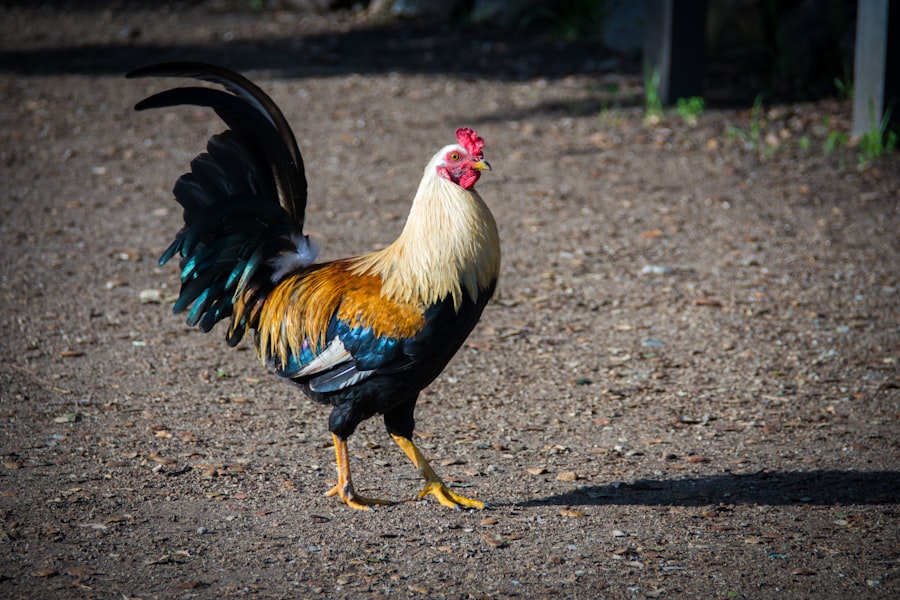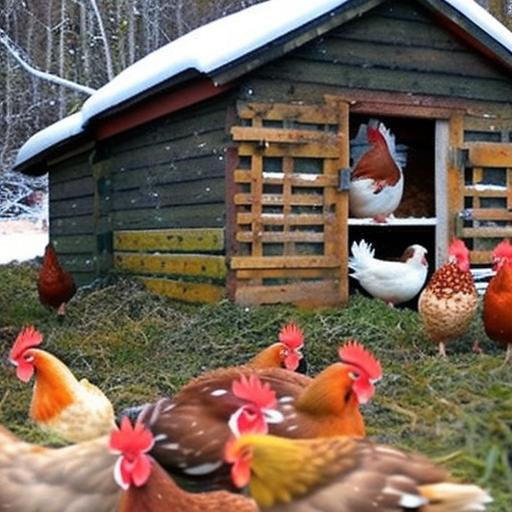Keeping chickens warm in the winter is essential for their health and well-being. As temperatures drop, chickens are more susceptible to cold-related health issues, such as frostbite and respiratory problems. It is important for chicken owners to take the necessary steps to ensure their chickens stay warm and healthy during the colder months.
Key Takeaways
- Keeping chickens warm is important for their health and egg production.
- Factors affecting chicken temperature tolerance include breed, age, and weather conditions.
- Insulating your chicken coop can help regulate temperature and prevent drafts.
- Choosing the right bedding material and adding heat sources can also help keep chickens warm.
- Proper ventilation is crucial for maintaining a healthy coop environment.
Why Keeping Chickens Warm is Important
Cold weather can have negative effects on chickens. Chickens are naturally more tolerant of cold temperatures than they are of heat, but extreme cold can still be harmful to them. Exposure to cold temperatures can lead to frostbite, which can cause tissue damage and even death in severe cases. Cold weather can also weaken a chicken’s immune system, making them more susceptible to respiratory infections.
Keeping chickens warm can prevent these health issues and also increase egg production. When chickens are exposed to cold temperatures, their bodies divert energy away from egg production and towards keeping warm. By providing a warm environment for your chickens, you can ensure that their energy is focused on egg production rather than staying warm.
Factors Affecting Chicken’s Temperature Tolerance
The natural temperature tolerance of chickens varies depending on factors such as age, breed, and feather quality. Young chickens and older chickens are more susceptible to cold temperatures than adult chickens. Young chickens have less body mass and less developed feathers, making it harder for them to regulate their body temperature. Older chickens may have weaker immune systems, making them more susceptible to cold-related health issues.
Different chicken breeds also have different temperature tolerances. Some breeds, such as the Rhode Island Red and the Plymouth Rock, are more cold-hardy and can tolerate colder temperatures than other breeds. Feather quality also plays a role in a chicken’s ability to tolerate cold temperatures. Chickens with dense, fluffy feathers are better equipped to keep warm than those with thin feathers.
Understanding Chicken Coop Insulation
Insulating your chicken coop is an effective way to keep your chickens warm during the winter. Insulation works by trapping heat inside the coop and preventing cold air from entering. It helps to maintain a stable and comfortable temperature for your chickens.
Insulation also has other benefits. It can help to reduce moisture and condensation inside the coop, which can lead to respiratory issues for your chickens. It can also help to reduce drafts, which can be harmful to chickens.
How to Insulate Your Chicken Coop
Insulating your chicken coop is a relatively simple process. Here are some step-by-step instructions:
1. Start by sealing any gaps or cracks in the coop walls and windows. Use caulk or weatherstripping to seal these areas and prevent drafts.
2. Next, add insulation to the walls and ceiling of the coop. There are several insulation materials you can use, such as fiberglass batts, foam boards, or reflective insulation. Choose a material that is safe for chickens and easy to install.
3. Install the insulation according to the manufacturer’s instructions. Make sure it is securely attached and covers all areas of the walls and ceiling.
4. Finally, cover the insulation with a layer of plywood or another sturdy material to protect it from damage.
Tips for Choosing the Right Bedding Material

Choosing the right bedding material for your chickens is important for their comfort and health. Bedding provides insulation and helps to keep your chickens warm during the winter months. It also absorbs moisture and odors, keeping the coop clean and dry.
There are several bedding options available, including straw, wood shavings, and shredded paper. Each option has its pros and cons. Straw is a popular choice because it is affordable and readily available. However, it can become damp and moldy if not replaced regularly. Wood shavings are another common choice because they are absorbent and provide good insulation. However, they can be dusty and may need to be replaced more frequently. Shredded paper is a more environmentally friendly option, but it may not provide as much insulation as straw or wood shavings.
When choosing bedding material, consider the needs of your chickens and the climate in your area. It is important to regularly clean and replace bedding to maintain a healthy environment for your chickens.
Strategies for Adding Heat to the Coop
Adding heat to your chicken coop can help to keep your chickens warm during the winter months. There are several ways to do this, including using heat lamps or heated waterers.
Heat lamps are a popular choice because they provide direct heat to the coop. However, they can be a fire hazard if not used properly. Make sure to securely hang the heat lamp and keep it away from flammable materials. Use a heat lamp with a built-in thermostat to regulate the temperature and prevent overheating.
Heated waterers are another option for adding heat to the coop. They provide warm water for your chickens to drink, which can help to keep them warm from the inside out. Make sure to choose a heated waterer that is safe for chickens and follow the manufacturer’s instructions for installation and use.
It is important to use these methods safely and monitor the temperature in the coop regularly. Avoid using space heaters or other heating devices that are not specifically designed for use in chicken coops, as they can be a fire hazard.
Best Practices for Draft Prevention
Drafts can be harmful to chickens, as they can cause cold air to circulate and create temperature fluctuations in the coop. To prevent drafts, make sure that all windows and doors are properly sealed. Use weatherstripping or caulk to seal any gaps or cracks in the coop walls. Insulate windows with plastic sheeting or bubble wrap to provide an extra layer of protection against drafts.
It is also important to ensure that the coop is well-ventilated without creating drafts. Proper ventilation helps to remove moisture and odors from the coop, which can help to prevent respiratory issues. Install vents or windows with adjustable openings to allow for airflow without creating drafts. Monitor the temperature and humidity levels in the coop regularly to ensure that it is properly ventilated.
The Importance of Proper Ventilation
Proper ventilation is essential for maintaining a healthy environment in your chicken coop. It helps to remove moisture, odors, and harmful gases, such as ammonia, from the coop. It also helps to regulate temperature and prevent the buildup of condensation, which can lead to respiratory issues for your chickens.
To ensure proper ventilation, make sure that the coop has enough vents or windows to allow for airflow. Install vents or windows with adjustable openings so that you can control the amount of airflow. It is important to strike a balance between ventilation and draft prevention. Monitor the temperature and humidity levels in the coop regularly to ensure that it is properly ventilated.
Ensuring Your Chickens Stay Warm and Healthy
Keeping chickens warm in the winter is crucial for their health and well-being. Cold weather can have negative effects on chickens, such as frostbite and respiratory problems. By taking the necessary steps to keep your chickens warm, such as insulating the coop, providing proper bedding, and adding heat if necessary, you can ensure that they stay healthy and comfortable during the colder months.
It is important to consider factors such as age, breed, and feather quality when determining how much warmth your chickens need. Young chickens and older chickens are more susceptible to cold temperatures than adult chickens. Different chicken breeds have different temperature tolerances, and feather quality plays a role in a chicken’s ability to tolerate cold temperatures.
By following best practices for draft prevention and ensuring proper ventilation in your chicken coop, you can create a warm and healthy environment for your chickens all winter long. Take the time to properly insulate your coop, choose the right bedding material, and monitor the temperature and humidity levels regularly. Your chickens will thank you for it with increased egg production and overall good health.
If you’re interested in learning how to keep chickens warm during the colder months, you might also find this article on “How Many Chickens Do You Need for a Family of 4?” from Poultry Wizard helpful. It provides valuable insights into determining the ideal number of chickens to raise for a family of four, taking into consideration factors such as egg production and consumption. Additionally, if you’re considering converting a shed into a chicken coop, Poultry Wizard has another informative article titled “Convert Shed to Chicken Coop” that offers step-by-step instructions and tips for creating a comfortable and safe living space for your feathered friends. For those interested in breeding geese, Poultry Wizard’s article on “What is the Incubation Period for Goose Eggs?” provides essential information on the duration and process of hatching goose eggs.
FAQs
What temperature range is ideal for chickens?
Chickens are comfortable in temperatures ranging from 50-80°F. However, they can tolerate temperatures as low as 20°F and as high as 90°F.
What are the signs of a cold chicken?
A cold chicken will appear lethargic, huddle together with other chickens, and may have a pale comb and wattles. They may also stop laying eggs.
How can I keep my chicken coop warm?
You can keep your chicken coop warm by insulating the walls and roof, using a heat lamp or ceramic heater, and providing plenty of bedding for the chickens to snuggle in.
What bedding is best for keeping chickens warm?
Straw, hay, and wood shavings are all good options for bedding to keep chickens warm. Avoid using newspaper or sawdust as they do not provide enough insulation.
Can I use a space heater to keep my chickens warm?
It is not recommended to use a space heater in a chicken coop as it can be a fire hazard. Instead, use a heat lamp or ceramic heater specifically designed for use in a chicken coop.
How can I prevent frostbite in my chickens?
To prevent frostbite in chickens, make sure the coop is well-ventilated to prevent moisture buildup, provide plenty of bedding for insulation, and apply petroleum jelly to the chickens’ combs and wattles to protect them from the cold.
Meet Walter, the feathered-friend fanatic of Florida! Nestled in the sunshine state, Walter struts through life with his feathered companions, clucking his way to happiness. With a coop that’s fancier than a five-star hotel, he’s the Don Juan of the chicken world. When he’s not teaching his hens to do the cha-cha, you’ll find him in a heated debate with his prized rooster, Sir Clucks-a-Lot. Walter’s poultry passion is no yolk; he’s the sunny-side-up guy you never knew you needed in your flock of friends!








